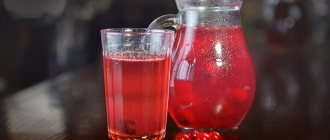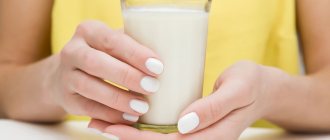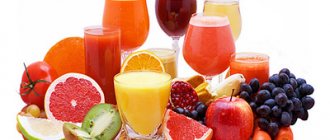Why is the plant so useful?
Chamomile is effective for stomach pain due to its chemical composition:
- Tannins;
- Free organic acids;
- Flavonoids;
- Retinol;
- Phytosterols;
- Ascorbic acid;
- Coumarina;
- Carotene.
The herb essential oil extract contains azulene, which guarantees a bacteriostatic and anti-inflammatory effect.
Products not recommended for consumption
The transition to a normal diet at home is one way or another accompanied by restrictions. In particular, people with peptic ulcers should exclude the following foods and dishes from their diet:
- fried meat, fish and poultry;
- rich broths and soups, in particular from meat, fish and mushrooms, as well as borscht and cabbage soup;
- radish, radishes, sorrel, raw onions, garlic, turnips, mushrooms and horseradish;
- smoked meats;
- pickled foods, seasonings and sauces;
- fatty dairy products, in particular cheese and cottage cheese;
- soft fresh white and black bread, puff pastry and pastry;
- carbonated drinks, coffee, alcohol.
Specific recommendations are made by the doctor, based on individual indicators, the patient’s condition, as well as the course of the disease, the location of the ulcer, the presence of concomitant and chronic diseases.
The effect of chamomile on the body
Due to the rich content of microelements, it has a positive effect on a person’s well-being and can replace medications in the initial stages of illness without negative consequences.
Chamomile is used instead of:
- Choleretic, sedatives and painkillers;
- Drugs intended to restore the mucous membranes of the gastrointestinal tract;
- Healing agents;
- Blood circulation stimulant.
Herbal decoction relieves toothache and sleep problems. If you treat a cut with it, the wound will heal with new skin much faster.
How does herbal tea affect the body?
With its regular use, beneficial microelements are absorbed into the blood, and toxins are removed from the body. Fermentation processes come to naught, colic and stomach problems disappear. The course of admission is from 10 to 90 days.
The use of inflorescences for the successful treatment of the intestines and stomach
The benefits of herbal medicine with chamomile for any method of treatment are undeniable. Herbal medicines:
- Reduces the degree of gas formation and flatulence.
- They are characterized by disinfectant and diaphoretic properties.
- Relieves symptoms of diseases and minimizes pain.
- They inhibit the development of inflammatory processes.
- Restore metabolic processes and functions of the digestive tract.
- They do not allow pathogenic flora to develop in the intestines.
Herbal medicine with chamomile reduces the degree of gas formation and flatulence
Which chamomile is suitable for herbal medicine of the stomach?
Inflorescences for making herbal infusions and teas are collected from mid-May to early August. For collection, meadows are chosen in areas remote from cities and busy roads.
The chamomile field is easily distinguished by its special aroma, which at this time can be heard from afar.
Only those plants whose peduncle size does not exceed 3 centimeters are suitable for medicinal purposes. Wet flowers quickly rot and spoil. Therefore, inflorescences are picked exclusively on sunny and dry days. In such weather, chamomile flowers are maximally filled with biologically active substances, which are so valued in medicine.
The inflorescences are carefully placed in baskets, positioned strictly horizontally, so that they do not fall apart during further drying.
While the collection continues, the cut flowers are tightly closed in containers protected from the sun so that they do not dry out and lose their beneficial properties. After drying, they are packaged and sent for sale.
Properly collected and dried chamomile inflorescences are characterized by a high content of microelements. Therefore, it is recommended to buy herbs in pharmacies and not in open markets, where storage rules are not followed.
The healing properties of chamomile also largely depend on how it is collected, at what time of day, at what time
Bloating and gas formation: modern treatment options
Bloating is a very common and very unpleasant symptom that makes a person suffer even more than from abdominal pain. Bloating is a gas-related symptom. The sensation of excess gas in the gastrointestinal tract (GIT) is most often associated with increased tension in the wall of the hollow organ and can be a consequence of both actual excess formation (and/or impaired removal of gases from the GIT) and the result of high visceral sensitivity.
The subjective feeling of bloating (part of the symptom complex of flatulence syndrome) is usually accompanied by painful objective manifestations: an increase in abdominal circumference, loud rumbling (borborygms), sudden release of gases through the mouth (belching), accompanied by specific sound manifestations, uncontrolled release of foul-smelling gases (flatulence). All these symptoms cause psychological discomfort, feelings of shame and guilt, and negatively affect mental status, leading to restlessness, anxiety, depression, and phobic moods. If bloating and associated problems become persistent, a person’s normal lifestyle, family and social relationships are disrupted, the quality of life decreases, and the range of social and behavioral activity is narrowed. As a rule, gas-associated symptoms worsen during periods of psycho-emotional stress, with changes in climatic and time zones, and changes in nutritional patterns.
The symptom of bloating has no age limit [1] and is one of the most common, observed in more than 85% of gastroenterological patients [2]. Among patients with a functional gastrointestinal disorder (FGID), abdominal bloating is observed in approximately 24–97% of patients and, in addition, very often occurs in patients with gastroesophageal reflux disease (GERD), diseases of the pancreas and gallbladder, premenstrual syndrome, and impaired intestinal motility . Patients suffering from irritable bowel syndrome (IBS) with bloating are more likely to visit the doctor, and the impact of their disease on quality of life is more pronounced than the impact of IBS without bloating [3].
Abdominal bloating occasionally occurs in almost all people and, as a rule, is clearly related to dietary habits, i.e., consumption of foods with a high gas-forming potential. Thus, according to the results of a population study conducted in our country among a practically healthy contingent of respondents, it was found that over the last week signs of flatulence were noted by 28%, over the last month - 44%, over the last year - 62% of respondents [4].
The prevalence of functional bloating in adults in the United States ranges from 6% to 31%, with an average pooled prevalence estimate of 15.9%, and is more common in women (19.2%) than in men (10.5%) [5].
The high variability in the prevalence of bloating is associated, firstly, with different perceptions of the term. Patients and doctors interpret the content of this concept differently (as a variant of a subjective feeling of fullness and bloating of the abdomen; the appearance of hardness and tension in the anterior abdominal wall; excessive formation and discharge of gases; and as an objective increase in abdominal girth, and, finally, as a manifestation of any other dyspeptic complaints). Secondly, some patients suffering from bloating do not seek medical help for a long time, in particular, because of the moral and ethical complexes that accompany the excessive formation of gases in the intestines; on the contrary, other people ignore these symptoms, believing they are of little significance for overall health. All this not only complicates the epidemiological assessment of the syndrome, but also does not allow us to formulate diagnostic criteria convenient for clinical practice and objective assessment of the effectiveness of drug therapy.
In the new edition of the Rome IV criteria, functional abdominal bloating/distension still forms part of a large group of functional gastrointestinal disorders of the gastrointestinal tract-central nervous system interaction (Table 1) and is considered as a diagnosis per se in patients who do not meet the Rome criteria within the framework of other gastrointestinal tract disorders, although the possibility of mild abdominal pain and/or minimal bowel movements is acceptable.
Experts of the Rome IV criteria propose to combine functional abdominal bloating and distension into one concept, although they emphasize that these symptoms can be observed in isolation, do not correlate with each other and have different pathophysiological mechanisms of development [6].
Functional bloating differs from other cases of abdominal distension in its circadian rhythm: in typical cases it increases after meals (usually after eating certain so-called problem foods) and during the day and decreases or disappears at night. Problematic foods include sugars, more specifically oligo- and polysaccharides, which pass unchanged into the large intestine, where they are fermented by fermenting and proteolytic microorganisms. This process is accompanied by the release of gas. Excessive perception of intestinal gases forms the symptoms of the disease [7].
Key points in the conceptual understanding of the pathogenesis of functional abdominal bloating/distension include visceral hypersensitivity, gas formation in the colon, and changes in gastrointestinal motility. The mechanisms associated with visceral hypersensitivity are fueled by alert anticipation of perceived unpleasant events. In the dysregulation of the brain-gut axis, genetic predisposition, environmental factors, chronic stress, and disorders of the intestinal microflora play a role [8].
Currently, the main causes of functional bloating are considered: visceral hypersensitivity, colonic fermentation, excessive bacterial growth in the small intestine and changes in the metabolic potential of the colon microbiota, disruption of intestinal transit and rectal gas evacuation [9].
The study of the pathophysiological mechanisms of development of the symptom of functional abdominal distension, thanks to innovations in diagnostics, including abdominal induction plethysmography (which makes it possible to measure abdominal distension), allows us to consider an abnormal viscerosomatic reflex involving the diaphragm and muscles of the anterior abdominal wall as the main predictor of the formation of this symptom. The mechanism of this reflex is not yet known. Studies have shown that colonic fermentation, decreased rectal sensation, and impaired intestinal transit may contribute to abdominal distension in some patients [9, 10].
The diagnosis of functional swelling must be established with indispensable reliance on 3 key positions: 1) anamnesis and clinical picture; 2) a thorough physical examination; 3) exclusion of anxiety symptoms with the minimum required set of laboratory and instrumental tests [11].
Despite the significant prevalence of functional bloating/distension of the abdomen, there are no clearly developed treatment algorithms for this pathology. The list of methods for effective treatment of bloating and distension is very limited (Table 2).
Some dietary changes, such as avoiding carbonated drinks and foods that tend to cause gas, can help reduce the symptoms associated with bloating. The exclusion from the diet of poorly digestible and assimilated short-chain carbohydrates (fermentable carbohydrates; oligo-, di- and monosaccharides; polyols) also has a positive effect, that is, bloating decreases when following a diet that excludes the entry into the colon of intensively fermentable substrates, such as wheat products; fruits rich in fructose (for example, apples, pears); vegetables containing fructans (onions, asparagus, etc.); products containing raffinose (for example, legumes, beets), sorbitol (sugar-free chewing gum) [3].
Helps prevent bloating caused by eating problematic foods by taking alpha-galactosidase (Orlix, dietary supplement) with meals. Alpha-galactosidase provides enzymatic activity missing in the human body, breaking down oligosaccharides into simpler, easily digestible forms. As a result of the use of Orlix, the amount of fermentable substrates entering the colon is reduced and the overproduction of gas associated with nutrition is prevented [12, 13].
In addition, some improvement can be expected from moderate physical activity, which facilitates bowel movements and gas transport.
Reduces the severity of bloating and abdominal distension by taking prokinetics. Prokinetics, accelerating intestinal transit, promote the movement of gas through the intestine and its removal to the outside [14]. However, prokinetics (lubiprostone and linaclotide), recommended by experts of the Rome IV criteria, for the treatment of bloating are not registered in our country. Among the drugs available on the Russian pharmaceutical market, trimebutine (Trimedat) is a universal regulator of gastrointestinal motility. Trimebutine is an opiate receptor agonist, its modulating effect on gastrointestinal motility and analgesic effect are associated with a nonspecific effect on all classes of peripheral opiate receptors: μ, κ and δ. Trimebutine stimulates the evacuation function of the stomach, normalizes intestinal motility and gas transit, reduces visceral sensitivity, helps relieve the feeling of bloating and discomfort, and has a beneficial effect in both hypokinetic and hyperkinetic forms of disorders of motor activity of the gastrointestinal tract. In the treatment of flatulence, a course prescription of the drug Trimedat 200 mg three times a day 30 minutes before meals for 30 days or more is indicated [15].
Currently, the study of the role of disturbances in the intestinal bacterial flora in the occurrence of gastrointestinal tract is ongoing. Thus, it was found that there are some species differences in the microbiome of healthy people and patients with bloating. This has prompted numerous clinical studies to study the effectiveness of antibiotics, probiotics and prebiotics for flatulence. Two probiotics have been shown to reduce visceral sensitivity in animal models: Bifidobacterium infantis and Lactobacterium acidophilus.
In the treatment of disorders associated with high levels of gas in the gastrointestinal tract, antiflatulents, or defoamers, are traditionally used. A drug that reduces foaming in the intestinal lumen is simethicone, which is a high-molecular silicon-based polymer - dimethylsiloxane with the addition of silicon dioxide. According to its mechanism of action, simethicone is a surfactant that reduces the surface tension of gas bubbles in chyme and mucus in the intestinal lumen, leading to their rupture. In this case, a process of coalescence occurs - the fusion of gas bubbles and the destruction of foam, as a result of which free gas is able to be absorbed through the intestinal mucosa or evacuated along with the intestinal contents. The dose is selected individually depending on the severity of symptoms. The main use of defoamers in clinical practice is the symptomatic treatment of various gastrointestinal diseases accompanied by excessive gas formation [2].
It is known that antidepressants modulate visceral sensitivity, they are often recommended for patients with gastrointestinal tract, but to date, based on the results of clinical studies, impressions of their effectiveness have not been definitively determined [3].
As a result, we have to admit that bloating and distension of the abdomen are difficult to treat. As soon as the connection of these symptoms with organic diseases is excluded, it is reasonable to place emphasis on the functional nature of these conditions, and in treatment it is advisable to pay attention primarily to the implementation of a diet and taking the biologically active food supplement Orlix.
The active component of Orlix is a natural enzyme - alpha-galactosidase (producer - the bacterium Aspergillus niger). 1 tablet contains 5 mg (corresponds to 150 units) of alpha-galactosidase. Does not contain GMOs, lactose, milk proteins, dyes, flavors and preservatives.
In order to study the effectiveness and tolerability of Orlix in patients with functional bloating/distension of the abdomen, an open, non-randomized, placebo-uncontrolled, multicenter study was conducted in Moscow city clinics.
Objectives of the clinical trial:
- To study the possibility of correction of gas-associated symptoms after ingestion of problematic foods in patients with functional bloating/distension of the abdomen when consuming Orlix with meals.
- Assessment of the tolerability of Orlix and its impact on quality of life.
Problematic foods:
- all types of beans (white, red, brown and their variants);
- lentils - all types;
- all types of cabbage (white, red);
- kohlrabi and Brussels sprouts;
- cauliflower and broccoli;
- salads of all kinds;
- onion garlic;
- carrots, parsley;
- flour and flour products (especially from wholemeal flour);
- pistachios and sesame;
- soybeans and soy products (soy milk, tofu).
Study design
The study involved 55 patients with complaints of flatulence (bloating, belching, increased passage of gas, a feeling of fullness in the abdomen, increased abdominal circumference) associated exclusively with the consumption of problematic foods, after excluding all other possible causes of gas-associated symptoms. Patients were examined according to a unified plan (general clinical analysis of blood, urine, stool, biochemical blood test, esogastroduodenoscopy, colonofibroscopy, ultrasound examination of the abdominal organs). At the end of the study, all patients underwent a repeat examination of general clinical and biochemical blood tests.
The average duration of complaints in patients included in the study was 3.5 years. The male to female ratio is 20:35. Average age 38 ± 5.5 years.
A prerequisite for patient inclusion in the study was the refusal to use any antiflatulent drugs and the continuation of taking problematic (gas-forming) products in the usual volume.
All patients included in the study took the dietary supplement Orlix with the first portion of problem food in a dose of 2–4 tablets for 2 months.
The effectiveness of Orlix was assessed based on the patient’s subjective assessment of the manifestations of flatulence at the beginning of the study, and then during the 1st and 2nd control studies (after one and two months of treatment, respectively) according to the severity of symptoms: 1st degree - all gases associated symptoms are completely eliminated, 2nd degree - mild symptoms of flatulence that do not bother the patient in everyday life, 3rd degree - improvement is observed, but in a mild form gas-associated symptoms persist, 4th degree - very little or no improvement.
As part of the overall assessment of the effectiveness of Orlix after 2 months of its use, based on a subjective assessment of the severity of symptoms of flatulence, patients were divided into 4 groups: 1st group - excellent - improvement of symptoms by 100% (corresponding to the assessment of the 1st degree), Group 2 - very good - improvement of symptoms by 50-80% (corresponding to a grade 2 assessment), Group 3 - moderate - improvement of symptoms by 30-50% (corresponding to a grade 3 assessment), 4th group - no changes - 0–30% (corresponds to a grade 4 assessment). All study statistics are based on patients' subjective assessment of gas-related symptoms after consuming problematic foods.
The effectiveness and safety of Orlix was also analyzed based on data from the SF-36 questionnaire to assess quality of life.
A study of anthropometric parameters (body weight and abdominal circumference) was carried out before the start of treatment and upon its completion.
Research results
Subjectively, already at the first control examination, 28 (50.9%) patients noted a complete elimination of the development of symptoms of flatulence after eating problematic foods while taking Orlix with meals; after 2 months of treatment, the number of patients with excellent effectiveness of Orlix increased to 32 (58.2 %).
Mild symptoms of flatulence persisted and did not bother the patient in everyday life in 19 (34.6%) patients at the end of the first month of treatment; subsequently, two of them noted the almost complete disappearance of gas-associated symptoms (with an increase in the single dose of Orlix to 3 tablets).
It is noteworthy that the number of patients who reported that, despite taking Orlix, they still had mild gas-associated symptoms, did not depend on the duration of treatment: 6 (10.9%) people at the 1st control and 5 ( 9.1%) at the end of observation. In one patient from this group, complete relief of abdominal bloating occurred when the single dose of Orlix was increased to 3 tablets.
Only 2 (3.6%) patients noted no improvement during the first month of treatment. One patient had the Orlix dose increased to 3 tablets per dose when consuming problematic foods, and against this background he noted a significant improvement. In another patient, increasing the dose of Orlix to 4 tablets per dose resulted in only minor relief of symptoms.
Thus, subjective improvement, despite continuing to take the usual amounts of problem foods, when using Orlix with meals was detected in 98.2% of patients (Table 3), and all of them noted the rapid onset of action of the biologically active food supplement when following the regimen taking Orlix with the first portions of food.
The overall assessment of the effect of Orlix after 2 months of its use, based on the patient’s subjective assessment of the severity of symptoms of flatulence, is presented in table. 4. An excellent effect was registered in 32 (58.2%) patients, a very good effect in 17 (30.9%), moderate improvement in symptoms was noted by 5 (9.1%) people. Only one patient in the study reported very little improvement in flatulence symptoms.
At the same time, not only subjective improvement was noted in patients; when studying the dynamics of anthropometric parameters, a tendency to a decrease in abdominal circumference was revealed, which was more pronounced in women while maintaining a constant body weight (Table 5).
When analyzing changes in the quality of life according to the nosologically nonspecific questionnaire SF-36 during treatment with Orlix, positive dynamics were also revealed: there was a significant improvement in the quality of life in almost all indicators of both physical and mental functioning. The mean physical functioning (PF) score increased from 85.1 ± 6.4 to 92.2 ± 2.1 points (p < 0.05); role physical functioning (RP) - from 51.3 ± 5.1 to 85.2 ± 2.3 points (p < 0.05); the general health (GH) score increased from 48.9 ± 8.4 to 61.21 ± 2.1 points (p < 0.05). Indicators of the psychological component of health changed as follows: vitality (VT): 54.6 ± 6.3 and 78.2 ± 4.9 points (p < 0.05); social functioning (SF) - 47.6 ± 11.2 and 68.8 ± 5.3 points (p < 0.05); role emotional functioning (RE) - 58.8 ± 8.4 and 70.2 ± 3.1 points (p < 0.05).
As part of the subjective assessment, the dosage of Orlix was statistically evaluated. At the beginning of the clinical study, a dosage of 2 tablets was prescribed to 32 (58.2%) patients, 3 tablets to 23 (41.8%) patients, a dosage of 4 tablets was not prescribed. During the first control, in 6 patients with the 3rd degree of severity of gas-associated symptoms, the dosage of Orlix was increased to 3 tablets and in 1 patient who did not notice an improvement in symptoms, the dose of the drug was increased to 4 tablets. However, increasing the dosage did not significantly affect the subjective feeling of the severity of flatulence symptoms. Thus, it was found that the dosage of Orlix is less correlated with the severity of gas-associated symptoms, and more dependent on the amount of food eaten; usually it is enough to take 2-3 tablets during a normal lunch (Table 6).
The dynamics of the main parameters of general clinical and biochemical blood tests (ALT, bilirubin, glucose) in the direction of deterioration were not observed (Table 7).
All patients noted good tolerability while taking Orlix; no adverse reactions were recorded.
Discussion
The study included patients with functional bloating/distension. All of them noted the connection between the occurrence of gas-associated symptoms and the consumption of problematic foods, such as beans, lentils, all types of cabbage, as well as kohlrabi, broccoli, salads of all types, onions, garlic, carrots, parsley, whole wheat flour products, pistachios and sesame seeds, soybeans and soy products. These products are united by a high content of oligosaccharides (melibiose, raffinose, stachyose, verbascose), formed by galactose and fructose, in various ratios (Table 8), since soy contains a lot of them, they are also called “soy oligosaccharides”.
Galactose (from the Greek root γaλακτ-, “milk”) is one of the simple sugars, a monosaccharide from the hexose group. D-galactose is widespread in nature, it is part of oligosaccharides (melibiose, raffinose, stachyose), some glycosides, plant and bacterial polysaccharides (gums, mucus, galactans, pectins, hemicelluloses), in animals and humans - in the composition of lactose, group-specific polysaccharides, cerebrosides, keratosulfate, etc. Fructose (fruit sugar), C6H12O6 - monosaccharide, isomer of glucose. In its free form, fructose is present in almost all sweet fruits, and also makes up up to 80% of honey; as a monosaccharide unit it is part of sucrose and lactulose.
Soy oligosaccharides are widely used in the food industry (soft drinks, candies, cakes, industrially prepared wheat products, dairy products, infant milk powder, etc.), and are included in many pharmaceuticals.
But human digestive enzymes are not able to break down the chemical bond between two galactose molecules, so these oligosucroses are not absorbed in the small intestine, but are hydrolyzed by enzymes of colon microbes (which have a set of enzymes that utilize soy sugars) with the formation of organic acids and large amounts of gases: H2, CH4 , CO2 (hence the name of products containing such oligosaccharides - gas-forming, or problematic).
As a result of research, it was possible to isolate a unique bacterial enzyme - α-galactosidase, which hydrolyzes galactosidase compounds, breaking down oligosaccharides into simple carbohydrates without the formation of gases. Such enzymes are found in the bacteria Bacteroides fragilis, Bacteroides thetaiotaomicron and Streptomyces avermitilis.
Alpha-galactosidases (syn. melibiases) have “exoactivity”, i.e. they cleave off the terminal non-reducing residues of alpha-D-galactose from the oligosaccharide molecule, hydrolyzing complex sugars to monosaccharides: glucose and galactose, which are absorbed by the cells of the intestinal mucosa and are used in body as a source of energy.
The use of the enzyme alpha-galactosidase in nutrition provides enzymatic activity absent in the human body, limiting the entry of oligosaccharides into the large intestine in an undigested form, where they undergo anaerobic bacterial hydrolysis with the formation of gases.
When adding this enzyme in the form of a dietary supplement to Orlix food, we found its effect in a group of 55 people to be excellent in 58.2%, and very good in 30.9%. Thus, patient-reported improvement after taking Orlix occurred in the vast majority of patients (89.1%).
When analyzing changes in quality of life according to the SF-36 questionnaire during monotherapy with Orlix, a significant improvement in quality of life was revealed in terms of both physical and psychological functioning.
All patients while taking Orlix noted that it was well tolerated.
Conclusion
In patients with functional bloating, taking the dietary supplement Orlix (active substance alpha-galactosidase) provides high effectiveness in relieving gas-associated symptoms and improves quality of life. Recommended dosage of Orlix: 2-3 tablets with meals with the first portions of food when consuming gas-forming foods. It is important to note that the onset of action of Orlix is immediate; flatulence does not occur when eating problematic foods. The dosage depends on the volume of problem foods eaten; 2-3 tablets are usually sufficient for average amounts of food. In the future, the patient can determine the optimal dose for himself.
Orlix is safe to use and can be recommended for healthy people who consume gas-producing products.
Reducing gas production in the intestines may represent an effective therapeutic strategy to prevent the development and/or exacerbation of gas-related symptoms in any gastrointestinal disease (functional or organic) when their cause is at least in part due to hyperproduction of gas.
Literature
- Belmer S.V., Gasilina T.V., Khavkin A.I. et al. Functional disorders of the digestive organs in children. M.: RGMU, 2005. 36 p.
- Butorova L.I., Kolomoets A.N., Tarasova E.S. Excessive gas formation syndrome in the intestines: clinical significance and principles of therapy // Difficult Patient. 2005.
- Functional disorders of the gastrointestinal tract. A practical approach based on clinical experience / Ed. B. E. Lacey, M. D. Crowell, D. C. DiBaiza. Per. from English edited by S. V. Demicheva. M.: GEOTAR-Media, 2022. 352 p.
- Flatulence syndrome in therapeutic practice: optimization of treatment approaches: educational manual / Ed. Yu. P. Uspensky. St. Petersburg: InformMed, 2010. 63 p.
- Sandler RS, Stewart WF, Liberman JN, Ricci JA, Zorich NL Abdominal pain, bloating, and diarrhea in the United States: prevalence and impact // Dig DisSci. 2000; 45:1166–1171.
- Drossman DA Functional gastrointestinal disorders: history, pathophysiology, clinical features and Rome IV // Gastroenterology. 2016; 150: 1262–1279.
- Agrawal A., Houghton LA, Lea R. et al. Bloating and distension in irritable bowel syndrome: The role of visceral sensation // Gastroenterology. 2008. Vol. 134. P. 1882–1889.
- Camilleri M., Lasch K., Zhou W. Irritable bowel syndrome: Methods, mechanisms, and pathophysiology. The confluence of increased permeability, inflammation, and pain in irritable bowel syndrome // Am J Physiol. Gastrointest. Liver Physiol. 2012, 303: 775–785.
- Lewis MJ, Reilly B, Houghton LA et al. Ambulatory abdominal inductance plethysmography: towards objective assessment of abdominal distension in irritable bowel syndrome // Gut. 2001; 48: 216–220.
- Houghton LA, Lea R, Agrawal A et al. Relationship of abdominal bloating to distention in irritable bowel syndrome and effect of bowel habit // Gastroenterology. 2006; 131:1003–1010.
- Pimanov S.I., Silivonchik N.N. Rome IV recommendations for the diagnosis and treatment of functional gastroenterological disorders. A manual for doctors. M., 2016. 160 p.
- Orlix®. Instructions for use.
- Expert opinion of the Federal Budgetary Institution of Health and Safety of Rospotrebnadzor No. 10–2 FC/2098 dated May 28, 2015.
- Cadarella M., Serra J., Azpinoz F. et al. Prokinetic effect in patients with intestinal gas retention // Gastroenterology. 2002. Vol. 122. P. 1748–1755.
- Ivashkin V. T., Poluektova E. A., Reykhat D. V. et al. Efficacy of the most commonly prescribed groups of drugs in patients with functional disorders of the gastrointestinal tract - functional dyspepsia syndrome and irritable bowel syndrome (Results of an observational study) // Ross. Journal of gastroenterology, hepatology, coloproctology. 2016; 26 (4): 15–23.
- Posserud I., Stotser PO, Bjornsson ES et al. Small intestinal bacterial overgrowth in patients with IBS // Gut. 2007. Vol. 56. P. 802–808.
L. I. Butorova*, 1, Candidate of Medical Sciences N. G. Kadnikova** M. A. Osadchuk*, Doctor of Medical Sciences, Professor T. E. Plavnik*** G. M. Tokmulina*, Candidate of Medical Sciences
* Federal State Autonomous Educational Institution of Higher Education First Moscow State Medical University named after. I. M. Sechenova Ministry of Health of the Russian Federation, Moscow ** TsKBVL FMBA “Goluboe”, Goluboe *** State Budgetary Institution of Public Health No. 195 DZM, Moscow
1 Contact information
Bloating and gas formation: modern treatment options / L. I. Butorova, N. G. Kadnikova, M. A. Osadchuk, T. E. Plavnik, G. M. Tokmulina
For citation: Attending physician No. 2/2018; Page numbers in the issue: 61-66 Tags: excess gas formation, enzymatic preparation
Recipes with chamomile
There are different ways to use the herb. It is used to make lotions, rinses, and washes of inflamed areas. But in the case of gastrointestinal diseases, the herbal medicine is taken orally.
Infusion
There are three known methods of preparation. They are all very simple. Choose any:
- 4 tbsp. spoons of flowers are poured into 200 ml of water and left to infuse for 3 hours in a thermos.
- Cold infusion. 10 teaspoons of flowers are poured into 2 glasses of chilled water. Leave for 10 hours.
- Hot infusion. 1 tbsp. pour a spoonful of chamomile into 1 cup of boiling water and let it brew for 30 minutes.
The peculiarity of the infusion for the stomach is that it should be taken exclusively warm 4 times a day before meals.
Chamomile tea
Recipe: Pour 1 bag of inflorescences with a glass of boiling water and let it brew for 5-7 minutes. Daily dose: 2-3 cups.
It will protect against viruses and bacteria, have a general strengthening and anti-inflammatory effect, and relieve indigestion.
Do not add sugar to the drink so as not to increase acidity in the stomach.
Decoction
Both dried and fresh plants are suitable. In the second case, you need to take three times more inflorescences than is written in the recipe.
- Pour 300 ml of chilled water into a container and add 1 tbsp. a spoonful of chamomile. Place in a water bath for 30 minutes, strain and cool.
- We take a small ladle, put 1 tablespoon of dry inflorescences and 200 ml of boiling water there. Put it on the fire and wait until the broth boils again. We simmer it for 5 minutes. Then remove the broth from the stove and leave for another 20 minutes.
When treating the stomach with chamomile, drink half a glass of decoction 3 times a day with the addition of a small amount of honey.
Liquid extract
It is made from alcohol and inflorescences. Chamomile-based liquid extract is prescribed for gastrointestinal diseases according to the following scheme:
- Dilute 5 ml of extract in 100 ml of water. Take 2-4 times a day 15 minutes before meals.
Before using the drug, visit your doctor. Alcohol is incompatible with many medications and can aggravate stomach conditions.
Benefits of Chamomile Tea
Chamomile appeared in healers’ medicine cabinets quite a long time ago, which is why it is called nothing less than pharmaceutical. It includes:
- Apigenin. A substance that can suppress allergies, inflammation of various natures, fight free radicals, and inhibit some types of cancer cells. Of all the herbs used to make teas, chamomile contains the highest amount of apigenin.
- Chrysin, which has strong sedative properties. This substance can reduce anxiety, causeless fear, unconditional panic attacks, hysterical state, and relieve nightmares.
- Coumarin. The substance that gives chamomile its characteristic aroma. Known as an antiallergic agent that relieves swelling, especially associated with impaired lymph circulation, postoperative.
- Ascorbic acid. The most important substance for the normal functioning of connective and bone tissues. Promotes the conversion of cholesterol into bile acids, which stimulates digestion and prevents the formation of gallstones. Is a powerful antioxidant.
- Tannins, which give the plant a bitter taste, help improve the functioning of the gastrointestinal tract, normalize the microflora in the intestines, and get rid of microbes and rotting products. Effective for preventing deposits of heavy metal salts, which cause significant harm to the entire body.
- Pectin. Doctors call it the “orderly worker” of the human body due to its ability to cleanse it of harmful substances without disturbing the natural microflora. Removes radioactive elements, toxic substances and pesticides from the body.
- Carotene. Actively participates in metabolic processes, is important for the formation of bones, nails, teeth, fat deposits, stimulates the growth of new cells, slows down aging, fights viruses and bacteria.
- Essential oils with antimicrobial, antispasmodic and regenerating properties. Vitamins, macro- and microelements: potassium, calcium, zinc, copper, iron, magnesium, manganese.
Unlike black and green tea, chamomile tea does not contain caffeine at all.
Monks from Tibet appreciated all the benefits and harms of chamomile tea, its ability to restore cells and stimulate their regeneration. Therefore, this plant is an essential ingredient in the famous Tibetan elixir of youth.
How to take chamomile for gastrointestinal problems
The benefits of chamomile in the treatment of diseases of the gastrointestinal tract are undeniable . If there are no contraindications or allergies, you should not refuse a natural antiseptic.
You can use herbal preparations for up to three months, but you need to agree on the regimen with your doctor.
Chamomile for poisoning
To eliminate the effects of poisoning, boil the chamomile infusion over low heat for 15 minutes, allow to cool and filter.
In case of poisoning, take the pure decoction warm. You need to drink about 1 liter of liquid per day. In case of severe intoxication, do a chamomile enema. With this approach, chamomile will be most beneficial for the stomach and intestines.
In case of poisoning, chamomile helps cope with inflammatory processes and has a calming effect on the digestive system.
How to forget about belching and heartburn?
To alleviate the condition, the herbal decoction is taken according to the standard regimen. A good effect is obtained by adding plantain and St. John's wort to the chamomile infusion. All herbs for the stomach are taken in equal proportions.
Chamomile tea against colitis
Colitis is common among intestinal diseases. The cause of the malaise is inflammatory processes provoked by poor-quality nutrition.
Chamomile tea inhibits the development of inflammation, reduces the number of fermentation processes, and stops the clinical symptoms of the disease, which are manifested by severe and sharp pain.
Does chamomile help with bloating and constipation?
Constipation is most often accompanied by terrible bloating. When a person suffers from gas and colic, chamomile tea helps a lot. It should be drunk in equal quantities throughout the day. If you have time, you can spend it preparing an infusion or decoction.
Chamomile decoctions for acute and chronic gastritis
Chamomile tea will relieve inflammation, pain, strengthen the immune system, and have a general calming effect.
Drink it 3 times a day, 1 glass. Cool beforehand. Hot drinks are contraindicated for gastritis.
How to treat stomach and duodenal ulcers with chamomile?
These diseases are often accompanied by severe pain. Chamomile helps relieve stomach ulcers. Course 31 days. Brew according to the standard recipe. Drink half a glass before or after meals, but no less than 25 minutes before.
Possibility of use for gastritis
Inflammation of the mucous membrane of the stomach wall is accompanied by pain, nausea, vomiting, dyspeptic disorders, and a feeling of heaviness in the epigastric region. Water infusions and decoctions with chamomile help reduce these symptoms and speed up the healing process.
Indications
Gastroenterologists recommend using chamomile for the following conditions:
- gastritis caused by a bacterial infection (foodborne infection);
- exacerbation of the chronic form of the disease;
- gastritis associated with nutritional factors (consumption of spicy and rough foods, overeating, alcohol abuse, taking certain medications).
Herbal decoctions and infusions are effective means of preventing relapses in chronic gastritis.
Who should avoid herbal medicine?
Chamomile is recognized as a hypoallergenic drug. It is added to preparations for the treatment of stomach in adults and children. But some contraindications still exist:
- Individual intolerance or allergic reaction.
- Hypoacid gastritis, characterized by low or zero acidity.
- Treatment of exacerbation of any gastrointestinal disease.
- The disease is in remission, requiring monitoring of the body's responses.
It is necessary to give up chamomile if the patient feels heaviness and aching pain in the stomach, nervousness and nausea, or dizziness. After stopping treatment, you must undergo an examination to exclude the serious consequences of self-medication.
It is necessary to give up chamomile if the patient feels heaviness and aching pain in the stomach.
Herbal medicine must not be combined with alcohol, blood thinners or sedatives.
Chamomile tea is not suitable for pregnant women or women who are planning to conceive. Any herbs can be given to infants only after consultation with a pediatrician.
Violating the dosage or frequency of administration is strictly prohibited!
Contraindications
Chamomile is one of the most universal herbs, the use of which has no side effects and is suitable even for small children. However, it is not for nothing that it is called medicinal. This means that you should treat it accordingly. Otherwise, a harmless glass of herbal drink can harm the body or lead to exacerbation of chronic diseases.
A chamomile drink is not recommended for people with individual intolerance to this herb. An excessive concentration of chamomile in tea will do more harm than good. This drink can cause headaches, low blood pressure, upset stools, and weakened muscle tone. Constantly drinking too strong tea will harm your emotional state, leading to a prolonged depressed or irritable mood, and loss of attention.
It is advisable to avoid chamomile tea when taking medications with a sedative and diuretic effect. Chamomile has similar properties, and such a mixture will cause an overdose with the corresponding consequences.
You should not drink chamomile tea if you have diarrhea. Take it with caution if you have low blood pressure.
Pregnant women should avoid chamomile tea completely or take it in a weaker concentration, no more than one glass per day. The plant stimulates the formation of estrogen, which can cause miscarriage.










